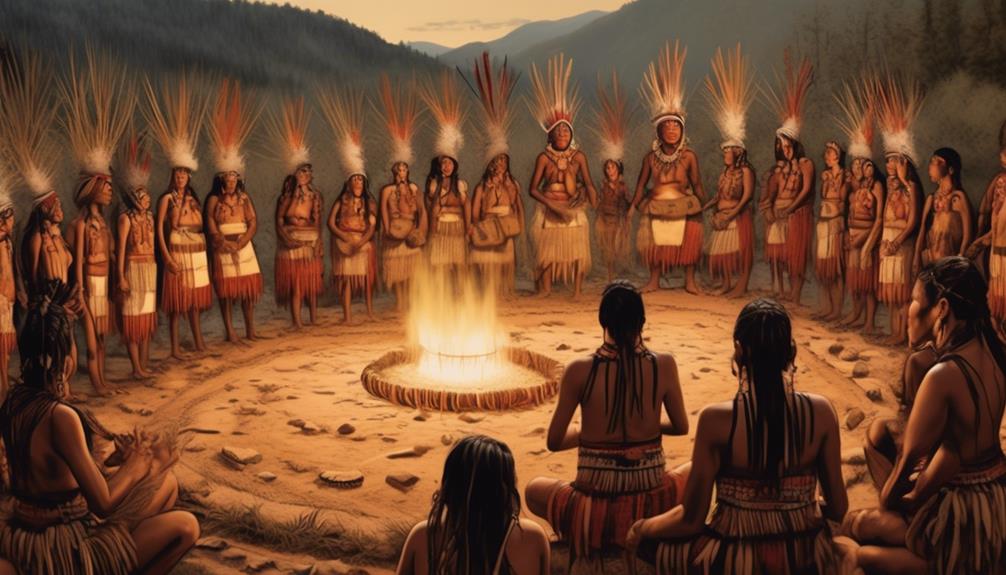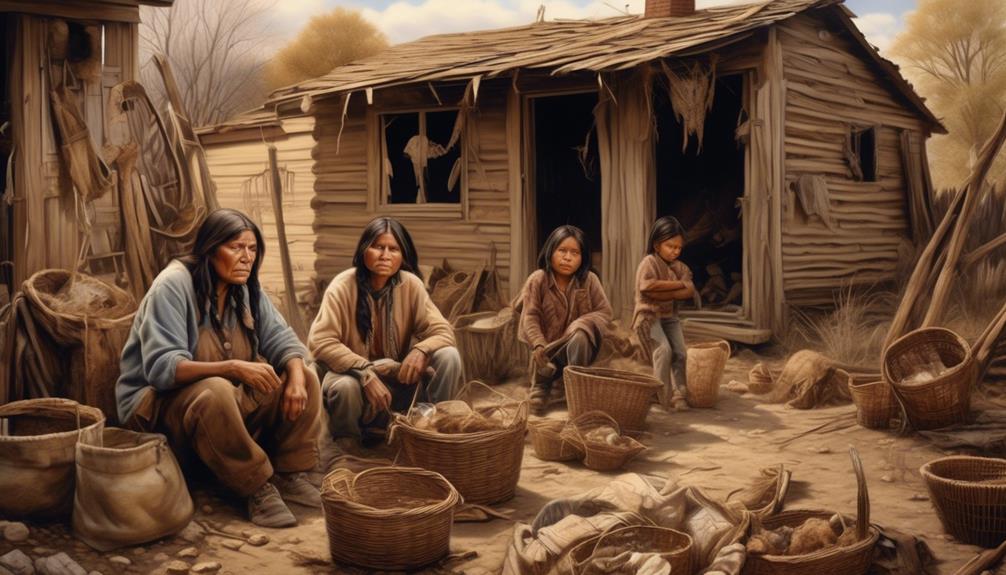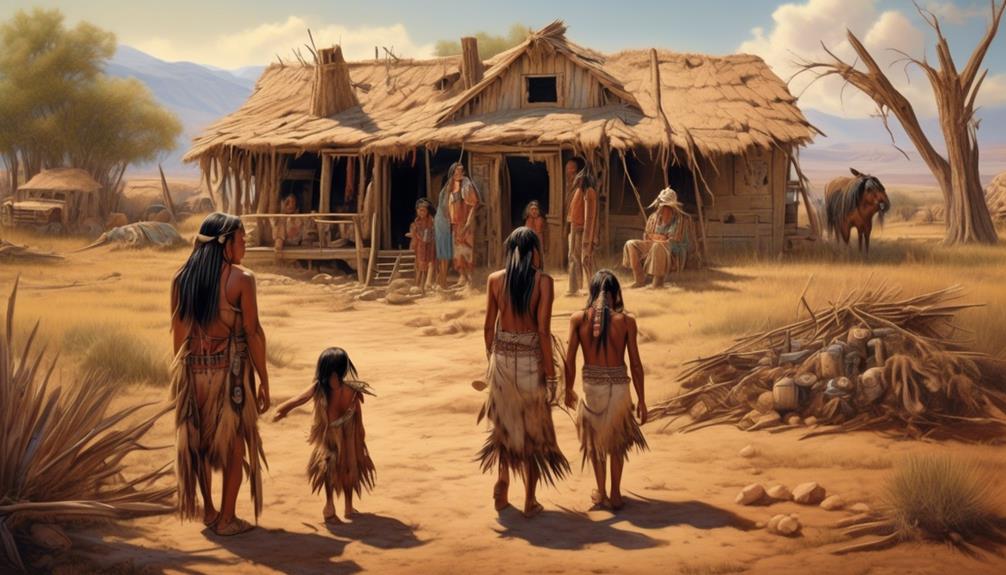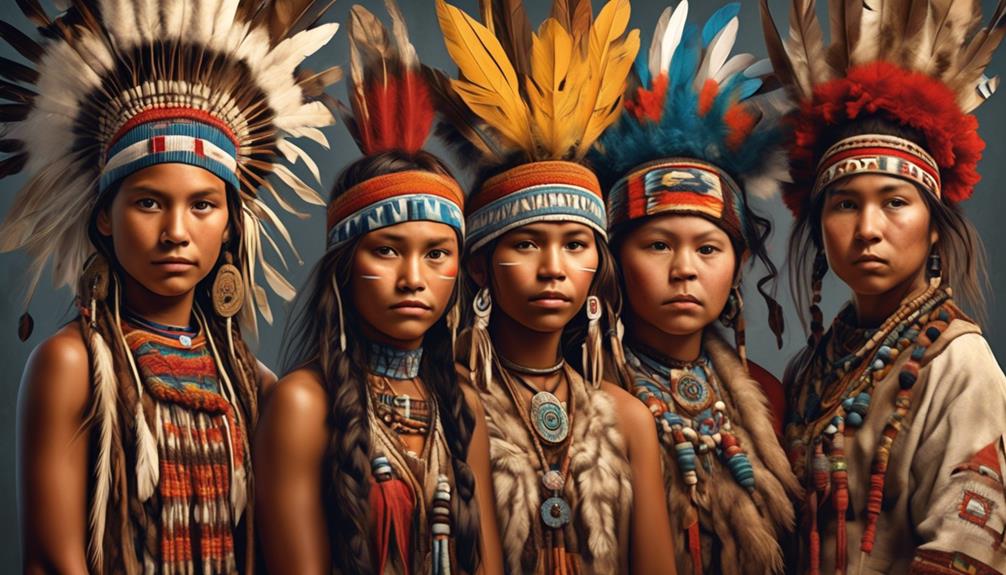By chance, the passing of the Dawes Act in 1887 brought about significant changes for Native Americans in the United States.
The impact of this legislation was profound, affecting not only the land ownership but also the cultural and economic fabric of Native American communities.
As we explore the repercussions of the Dawes Act, we will uncover the complex web of consequences that continue to shape the lives of indigenous people today, shedding light on a pivotal moment in history that warrants our attention and understanding.
Key Takeaways
- Loss of Tribal Land and Displacement: The Dawes Act resulted in the forced removal of Indigenous people from their ancestral lands, leading to the loss of millions of acres of Indigenous land and the breakdown of communal land ownership. This resulted in severed cultural and spiritual ties to the land, as well as the loss of sacred sites and cultural practices.
- Erosion of Cultural Practices: The Dawes Act contributed to the cultural assimilation of Indigenous people into dominant white American culture. It led to the loss of traditional customs and practices, the adoption of an agrarian lifestyle, and the abandonment of nomadic traditions. Indigenous languages and religious practices were also prohibited.
- Economic Hardships and Poverty: The Dawes Act had a detrimental impact on the economic well-being of Indigenous people. It made it difficult for them to access employment opportunities, as shared land was fragmented, inhibiting efficient agricultural practices. This limited economic independence and perpetuated cycles of poverty, while also disrupting traditional agricultural practices.
- Emotional and Psychological Distress: The Dawes Act subjected Indigenous people to marginalization, poverty, and emotional and psychological distress. It resulted in intergenerational trauma, with psychological and emotional wounds being passed down through generations. The act had a lasting impact on the emotional well-being of Indigenous communities.
Loss of Tribal Land
The Dawes Act significantly impacted Indigenous people by forcibly removing them from their tribal lands, leading to the loss of their ancestral territories and the disruption of their traditional ways of life. This forced assimilation policy aimed at allotting land to individual Native Americans, with the goal of encouraging private land ownership and agriculture.
However, the act had devastating consequences. It resulted in the loss of millions of acres of Indigenous land, breaking communal land ownership and forcing Indigenous people to abandon their traditional practices and lifestyles. The push towards individual land ownership disregarded the communal nature of Indigenous societies and their deep spiritual connection to the land.
This disruption not only caused immense economic hardship but also severed the cultural and spiritual ties that Indigenous people had with their ancestral territories. The loss of tribal land due to the Dawes Act stands as a stark example of the detrimental impact of policies that prioritize forced assimilation over respecting and preserving Indigenous traditions and land rights.
Erosion of Cultural Practices

Having examined the devastating loss of tribal land caused by the Dawes Act, it is crucial to now address the erosion of cultural practices among Indigenous communities as a direct consequence of this policy. The Dawes Act not only forcibly removed Indigenous peoples from their ancestral lands but also sought to assimilate them into the dominant white American culture. This deliberate cultural assimilation led to the erosion of traditional customs and practices that had been central to Indigenous identities for generations.
| Impact of the Dawes Act on Indigenous Culture |
|---|
| Cultural Assimilation |
| Loss of Traditional Customs |
The Dawes Act dismantled communal land ownership, pushing Indigenous individuals towards adopting an agrarian lifestyle and abandoning their nomadic traditions. As a result, spiritual connections to the land were disrupted, leading to a loss of cultural identity and traditional knowledge. Moreover, the prohibition of Indigenous languages and religious practices in government-run boarding schools further accelerated the erosion of Indigenous cultures. This deliberate undermining of traditional customs had profound and long-lasting effects on Indigenous communities, contributing to the loss of languages, ceremonies, and ways of life that had been integral to their identity.
Displacement of Native Americans
Indigenous communities experienced significant displacement due to the implementation of the Dawes Act, resulting in profound and enduring consequences for their way of life. This forced relocation and land dispossession had devastating effects on Native American tribes, leading to a multitude of challenges that persist to this day.
- Breakdown of Traditional Social Structures: The forced relocation of Native American communities disrupted their traditional social systems, leading to a breakdown of familial and communal ties. This upheaval caused immense emotional and psychological distress, as individuals and families were torn from their ancestral lands and separated from their cultural heritage.
- Loss of Spiritual and Cultural Connection: The displacement resulted in the loss of sacred sites and cultural practices essential to the spiritual well-being of Native American tribes. This severance from their spiritual and cultural roots inflicted deep trauma and a sense of loss that continues to impact indigenous communities.
- Marginalization and Poverty: Displacement and land dispossession left Native Americans marginalized and impoverished, as they struggled to adapt to unfamiliar environments and economic systems. This perpetuated cycles of poverty and disenfranchisement, exacerbating the challenges faced by indigenous peoples.
The Dawes Act's legacy of forced relocation and land dispossession continues to shape the experiences of Native American communities, underscoring the enduring impact of these policies on indigenous lives.
Economic Hardships and Poverty

Experiencing economic hardships and poverty, Native American communities grapple with enduring challenges stemming from the historical impact of the Dawes Act. The Act's provisions led to the loss of communal land ownership and disrupted traditional agricultural practices, resulting in severe economic repercussions for Indigenous peoples. The forced assimilation into mainstream American society further hindered their ability to access employment opportunities and maintain self-sufficiency within their communities.
The Dawes Act's division of tribal lands into individual allotments severely undermined the economic stability of Native American communities. The fragmentation of once-shared land inhibited efficient agricultural practices and rendered many unable to sustain themselves. Consequently, this loss of economic independence perpetuated cycles of poverty that continue to affect Indigenous communities today.
Moreover, the Act's assimilationist policies, such as the implementation of boarding schools and the suppression of cultural practices, further marginalized Indigenous peoples, limiting their access to employment opportunities and economic advancement. This deliberate disruption of traditional ways of life compounded the economic hardships faced by Native American communities, leaving a lasting impact on their socio-economic well-being.
Long-Term Legacy and Impact
The long-term legacy and impact of the Dawes Act on Native American communities continues to shape their socio-economic realities, perpetuating enduring challenges rooted in historical policies of land division and assimilation. The repercussions of this government policy are deeply entrenched in the fabric of Native American societies, with profound implications for their present-day circumstances.
- Intergenerational Trauma: The Dawes Act not only led to immediate displacement and loss of land but also inflicted lasting psychological and emotional wounds on Native American communities. The trauma from forced assimilation, cultural erasure, and the disruption of traditional ways of life has been passed down through generations, contributing to ongoing social and mental health challenges.
- Continued Dispossession: The legacy of the Dawes Act is evident in the continued struggle for land rights and sovereignty faced by many Native American tribes. The fragmentation of communal land holdings and the loss of traditional territories have hindered economic development and self-sufficiency, perpetuating cycles of poverty and dependency.
- Systemic Inequality: Government policies like the Dawes Act have entrenched systemic inequality, contributing to disparities in education, healthcare, and employment opportunities for Native Americans. The enduring impact of these policies underscores the need for meaningful reconciliation and redress to address historical injustices and support the self-determination of Indigenous peoples.
Frequently Asked Questions
How Did the Dawes Act Impact the Relationship Between IndigenoUS Tribes and the US Government in Terms of Sovereignty and Self-Governance?
The Dawes Act significantly impacted the relationship between indigenous tribes and the US government in terms of sovereignty and self-governance.
Sovereignty was impacted as the Act aimed to assimilate tribes into American society, diminishing their autonomy.
Self-governance faced challenges as tribal lands were divided, leading to the loss of communal decision-making.
The Act fundamentally altered the traditional governance structures, eroding the indigenous peoples' ability to govern themselves independently.
What Were the Long-Term Effects of the Dawes Act on Indigenous Languages and Traditional Knowledge?
Preserving Indigenous languages and traditional knowledge became a struggle after the Dawes Act. The Act's land allotments disrupted cultural practices, leading to loss of language and traditions. This eroded sovereignty and inflicted intergenerational trauma.
Economic impact compounded these losses. The Act's impact on cultural preservation remains a grave concern, as it disrupted the transmission of traditional knowledge.
How Did the Displacement of Native Americans Due to the Dawes Act Affect Their Connections to Their Ancestral Lands and Cultural Identity?
Displacement of Native Americans due to the Dawes Act severed ancestral ties, disrupting cultural preservation. The forced relocation shattered our connection to sacred lands and traditions.
This systematic dismantling of our identity left lasting scars, impacting future generations. The loss of ancestral lands and cultural roots inflicted deep wounds, leading to a struggle for survival and preservation of our heritage.
The Dawes Act's impact on our ancestral ties and cultural identity resonates through history, demanding recognition and reconciliation.
What Were the Specific Economic Challenges Faced by Indigenous Communities as a Result of the Dawes Act, and How Did These Challenges Persist Over Time?
Economic hardships resulted from land loss caused by the Dawes Act. This led to persistent challenges for indigenous communities. The impact on tribal sovereignty has been profound, affecting cultural preservation.
The Act's policies disrupted traditional economic systems, exacerbating poverty. These consequences persist today, requiring understanding and support for indigenous communities to address historical injustices and work towards economic empowerment and cultural preservation.
How Did the Dawes Act Contribute to the Intergenerational Trauma and Social Issues Experienced by Indigenous Peoples in the United States Today?
The Dawes Act significantly contributed to the intergenerational trauma experienced by Indigenous peoples in the United States today. It resulted in the loss of land rights, disrupted cultural preservation, and perpetuated social injustices.
Today, this history continues to impact Indigenous communities, with over 1.5 million American Indians and Alaska Natives living in poverty, highlighting the enduring effects of the Act on Indigenous peoples' well-being and social conditions.
Conclusion
In conclusion, the Dawes Act had a devastating impact on indigenous people. It led to the loss of tribal land, erosion of cultural practices, displacement, and economic hardships. The long-term legacy of this act continues to affect Native American communities today.
It's like a storm that swept through a beautiful garden, uprooting the flowers and leaving behind a barren landscape.
We must acknowledge and address the lasting effects of this historical injustice with empathy and understanding.









